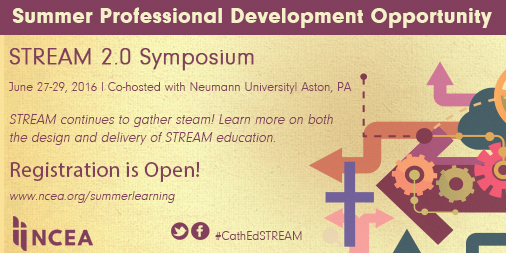
This post was contributed by Ann Kaiser, STEM Education Consultant, CEO ProjectEngin LLC.
Teachers Share Their Experiences and Some Ideas for Classroom Activities
The Newark Archdiocese has had a number of STEM/STREAM initiatives underway throughout the 2015-2016 academic year. Many of these programs have been supported and designed by ProjectEngin, a STEM education consulting firm. The initial program, “Engineering 21st Century Science Curriculum”, consisted of an extensive introductory 2 day workshop and several follow-up workshops held during the school year. Teachers who participated received a wide range of resources and supporting materials, as well as ongoing feedback and information. A number have become dedicated practitioners of active learning techniques in middle school science classrooms and love to share the amazing work that the young “engineers” in their classrooms are doing.
Several of these teachers will take part in a panel discussion at the NCEA STREAM 2.0 Symposium. They will discuss the challenges and rewards, pros and cons, and plans for the future. In preparation, they have shared the following thoughts and insights.
JoAnne Sommer teaches 4th – 6th grade science at St. Aloysius Elementary Academy in Jersey City. St. Aloysius has made a real effort towards focusing on STEM throughout their K-8 program. Students in JoAnne’s classes undertook an extensive biomimicry-based project to engineer camouflage for nature photographers, as well as a project to design better ways to filter water. JoAnne states that “Throughout the school year students participated in many different STEM lessons. They were both quick builds and extended lessons. The overall leaning and enthusiasm of the children created a great learning experience for them and myself. The goal of every teacher is to allow students to use their individual talents to succeed in life and STEM projects really allow this to happen.”
Valerie Schroeder and Joan Luciano teach at St. John’s Academy in Hillsdale, NJ and report that they are committed to infusing everything they learn at ProjectEngin workshops into their classroom. Their experiences in their 6th grade classes were mostly focused on design and building and covered a wide range of science and math concepts. These included the Marshmallow Design Challenge and the following activities that they designed themselves. Try some in your own classrooms and watch learning come alive!
- Expanded Given Uses of an Object –
- Each group receives a different object:
- screw
- eraser
- fork
- magnetic clip
- safety pin
- binder clip
- glue stick
- plastic container
- On a piece of paper, write its purpose and all of its uses and how to use it, as if speaking to a person who has never seen the object
- Draw a sketch of an improvement you can make to this object. Explain.
- Each group receives a different object:
- A Spider’s Web – create a spider web that is at least 1ft in diameter that can withstand the force of a various sized balls. Students are self-guided through a series of follow-up questions to examine what they built, how they built it and how they can modify their structure to improve the strength. This build simulations structures withstanding the elements in various climates.
- A Table for Two – Using the fewest amount of craft sticks, create a mini-table that can support a canned soft drink. Students are self-guided through a series of follow-up questions to examine what they built, how they built it and how they can modify their structure to improve the strength. This build simulations a possible real structure that is needed to hold a certain weight i.e. truck bed, forklift, stage, platform, deck, floor of a building etc.
A number of other middle school level teachers have reported great success in implementing new activities ranging from short, 15 minute “Quick Builds” to more extensive multi-class projects. Their experience is that you basically just need to make the leap and try something new. The support provided by the diocese, their administrators, and ProjectEngin went a long way toward making that leap easier. And the resulting engagement and enthusiasm shown by their students makes continuing the journey something an easy commitment!